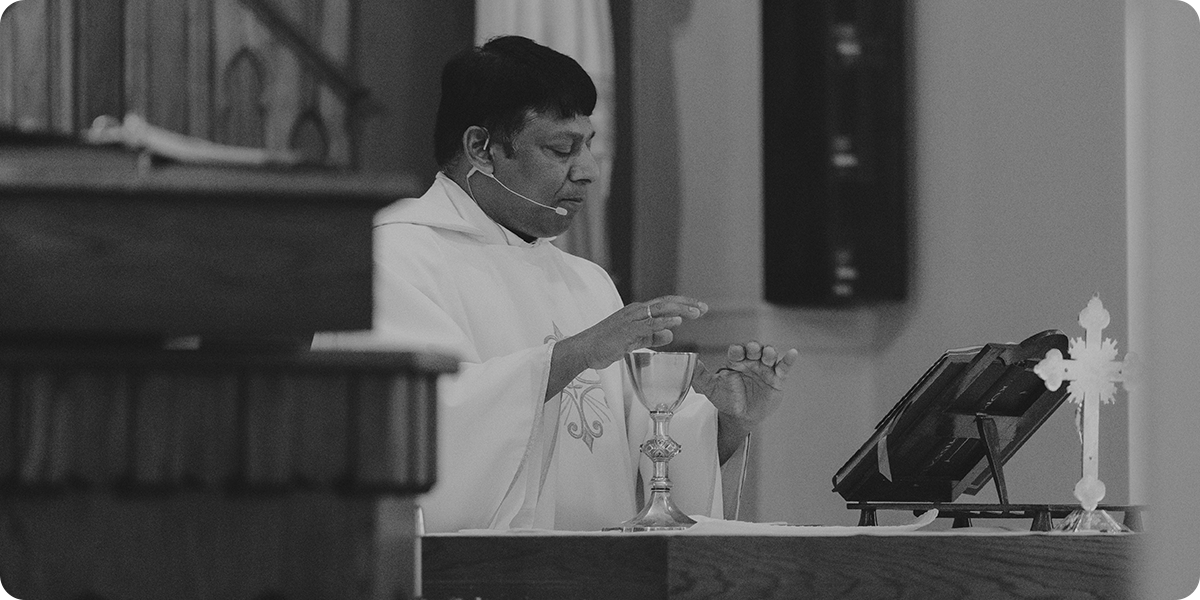

Having just joined the angels in singing the Holy, Holy, Holy, we next kneel down in adoration for the Eucharistic Prayer. Why do we kneel at this time? We kneel to prepare ourselves for the Lord Jesus to be really, truly, and substantially present on the altar. As Fr. Stefano Manelli relates, St. Louis IX, King of France, who was known to be regularly at Mass and would kneel on the floor, once said, “At Mass God offers Himself as a sacrifice, and when God sacrifices Himself, kings should kneel on the floor” (Jesus Our Eucharistic Love, p. 24). Adoration of Jesus in the Blessed Sacrament is really an extension of the adoration we have for Jesus on the altar after the Consecration and in the elevations of the Body and Blood of Jesus in the Mass.

You may have noticed that there are several options for the Eucharistic Prayer, which begins after the Sanctus. Although each Eucharistic Prayer is unique and has particular emphases, each has the same main elements, including the epiclesis, institution narrative and Consecration, anamnesis, oblation, intercessions, and concluding doxology. We will cover each element in detail as we continue.
Looking through our current Roman Missal, we find ten Eucharistic Prayers from which the priest can choose. The first four (The Roman Canon: Eucharistic Prayer I, along with Eucharistic Prayers II, III, and IV) are probably the most familiar, as they are often included in worship aids and other prayer books. The Missal also includes two Eucharistic Prayers for Reconciliation and four Prayers for Masses for Various Needs. These options have the following titles: “The Church on the Path of Unity”; “God Guides His Church along the Way of Salvation”; “Jesus, the Way to the Father”; and “Jesus, Who Went About Doing Good.” These last four prayers come with suggestions for when they might be appropriate to use; for example, the prayer “Jesus, the Way to the Father” would be a good fit for a Mass “For the Evangelization of Peoples” or “For Persecuted Christians.” There are also three Eucharistic Prayers for Masses with children (found in a separate book and prescribed only for Masses in which the majority of the participants are children).

Sometimes people ask if I have a favorite Eucharistic Prayer. My honest answer is that each one is special in its own way. I really do like each of them! Eucharistic Prayer I includes many names of saints, which reminds me that we are supported by the witness and prayers of those who have gone before us (more on these saints in the near future). It also has several unique prayers for special days like Christmas and Easter. Eucharistic Prayer I is also called the Roman Canon, indicating its origin and centuries-long use in the Latin Rite of the Roman Catholic Church. Eucharistic Prayer II has some of the oldest known prayers in the Mass, which go back to the 200s A.D. I am always strengthened by the thought that those early saints and martyrs were praying almost word-for-word the same words we use today; that is unity throughout time and place! Eucharistic Prayer III notes the Holy Spirit in particular and has a place for inserting the name of the saint of the day or patron saints. Eucharistic Prayer IV is really a tour of salvation history and reminds me of the Gospel of St. John with phrases like, “And you so loved the world, Father most holy, that in the fullness of time you sent your Only Begotten Son to be our Savior.”

Among the other Eucharistic Prayers, here are a few phrases that I really love to pray: “Help us to work together for the coming of your Kingdom, until the hour when we stand before you, Saints among the Saints in the halls of heaven” (Reconciliation I). “May he make your Church a sign of unity and an instrument of your peace among all people” (Reconciliation II). “Lord renew your Church (which is in N.) by the light of the Gospel” (Various Needs I). “And so, having called us to your table, Lord, confirm us in unity…” (Various Needs II). “You are indeed Holy and to be glorified, O God, who love the human race and who always walk with us on the journey of life” (Various Needs III).“Open our eyes to the needs of our brothers and sisters; inspire in us words and actions to comfort those who labor and are burdened” (Various Needs IV).
After taking a closer look, we see there really is a rich variety in the different prayers we can use at the altar in the Mass. Whichever of these Eucharistic Prayers is prayed, be assured that the same holy sacrifice of Christ takes place, glory and honor is given to God, and the very Body and Blood of Jesus becomes present on the altar in front of us!
1. Take time to pray, slowly, with each of Father Luke’s favorite phrases from different options of the Eucharistic Prayer. Make note of the insights or inspirations you receive in prayer.
2. Next time you participate in Mass, engage the celebrant afterward by asking about which Eucharistic Prayer he chose. As you get to know the Eucharist Prayer options better, see if you can identify which prayer you hear.